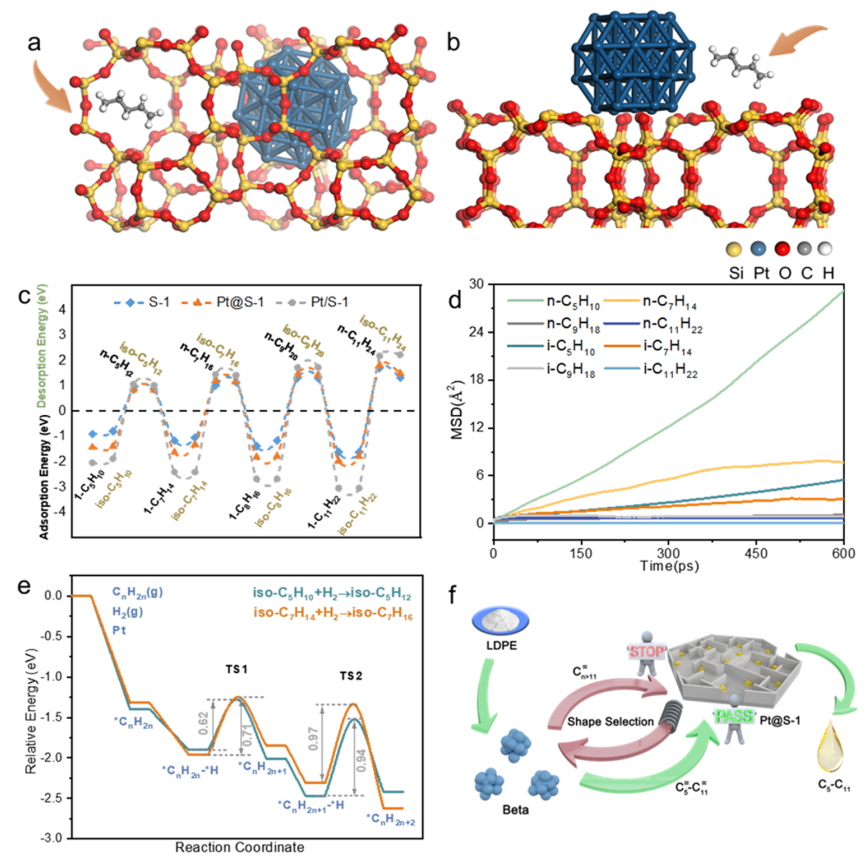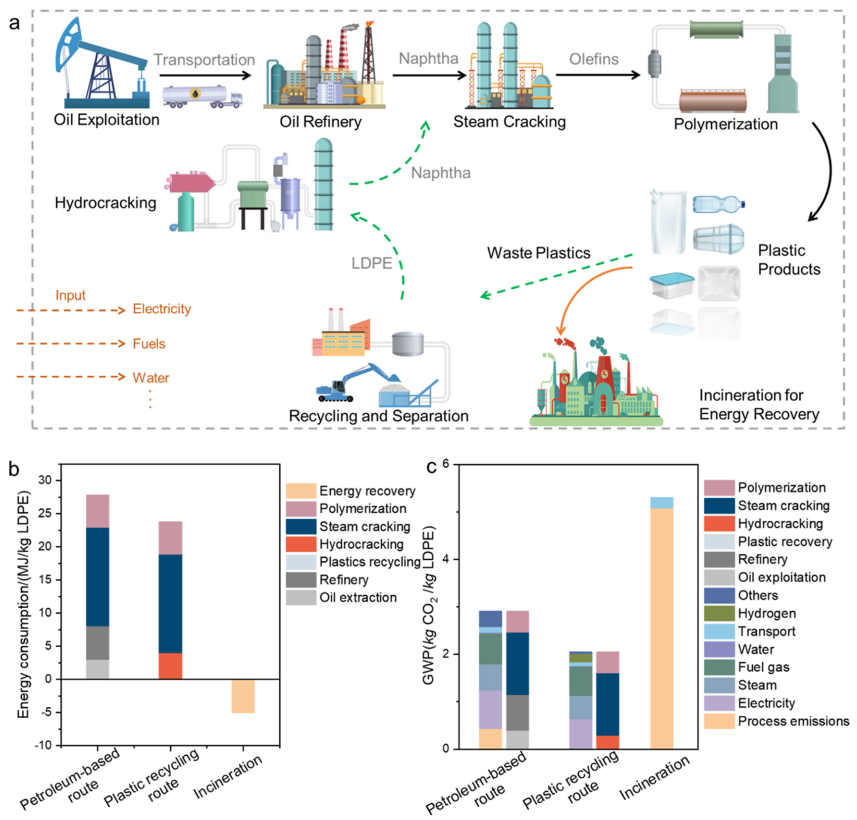Time:2023-01-11 Reading:4223
Recently, Researcher Wang Hui from the Shanghai Advanced Research Institute of the Chinese Academy of Sciences and Senior Engineer Luo's R&D team made important strides in enhancing the quality and utility of waste plastics. Their research, entitled "Converting Plastic Wastes to Naphtha for Closing the Plastic Loop," has been published in the top-tier Journal of the American Chemical Society. The Low-Carbon Platform partially participated in and completed associated theoretical calculations and carbon emissions tasks.


To further elucidate the process of molecular sieve selectivity and reaction mechanisms, the Low-Carbon Platform participated in a collaborative effort on theoretical calculations, employing Density Functional Theory (DFT) and Molecular Dynamics simulations. The results indicate that for olefins ranging from C5 to C11, the adsorption energy decreases progressively. Multi-sites on longer-chain molecules enhance adsorption stability, and an appropriate level of adsorption energy is conducive for olefin adsorption and alkane desorption.
Simulations were conducted on the diffusion rates of different olefins on Pt@S-1, revealing that shorter-chain olefins could diffuse more rapidly within the zeolite pores. In contrast, the addition of side-chain structures increased diffusion resistance and hindered fluidity. The rapid diffusion of short-chain olefins facilitates their contact with platinum nanoparticles and subsequent hydrogenation reactions, thereby improving the selectivity for C5-C7 hydrocarbons.


A comprehensive Life Cycle Assessment (LCA) was conducted on the plastic processing workflow to analyze the carbon footprint at various stages, including raw material acquisition, production, usage, and recycling. The carbon emissions for each phase from raw material to Low-Density Polyethylene (LDPE) consumption were calculated. The findings show that recycling plastics can result in a 15% energy savings and a 30% reduction in greenhouse gas emissions.

![]()
Link:
https://doi.org/10.1021/jacs.2c11407
Introduction
The Shanghai Institute of Cleantech Innovation is a collaborative venture initiated by the Songjiang District Government of Shanghai and the Shanghai Advanced Research Institute of the Chinese Academy of Sciences. Backed by the company's analytical testing platform and high-quality "supercomputer" resources, the institute specializes in the integration and innovation of experimental science. It combines this with high-performance computing technology to offer professional theoretical computation and simulation services. It provides technical support for domestic and international research institutions as well as corporate research teams, thereby increasing the efficiency of scientific research and enterprise R&D.
Technical Capabilities
Leveraging technologies like Quantum Chemistry, Density Functional Theory (DFT), Molecular Dynamics (MD), Computational Fluid Dynamics (CFD), and High-Throughput Computing/Machine Learning, the institute can conduct multi-level research including model building, property calculations and predictions, active site and mechanism studies, and further materials screening and forecasting. This involves literature reviews, the formulation of computational schemes, and computational simulations, culminating in the completion of theoretical computation research projects.
Current theoretical computational solutions provided include (but are not limited to):
1. Geometric Properties: Model construction and optimization (stable structures, surface reconstructions, defects, etc.);
2. Surface Properties: Surface adsorption energy, surface energy, surface electrostatic potential, work function, etc.;
3. Electronic Properties: Density of states, band structures, charge density distribution, Electron Localization Function (ELF), Bader charges, Fukui function, etc.;
4. Thermodynamic Properties: Zero-point energy, Gibbs free energy, etc.;
5. Transition States: Reaction barriers, reaction mechanisms, reaction rates, etc.;
6. Molecular Dynamics (MD/AIMD) Simulations: Interface properties, etc.
Carbon Accounting Services/Carbon Footprint Analysis:
1. Corporate/Organizational Carbon Accounting: Based on domestic industry greenhouse gas accounting guidelines or international standards like ISO14064, GHG Protocol, etc., it provides services like calculating carbon emissions and compiling emission reports;
2. Carbon Footprint Analysis: Using real-world data and background data provided by the Gabi database for product carbon footprint analysis;
3. Corporate/Organizational Carbon Neutrality/Energy-saving and Emission Reduction Plan Development;
4. Policy Tracking and Interpretation, Industry Dual Carbon Trend Research, and Consultation, etc.